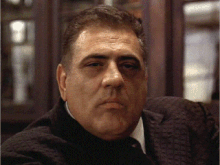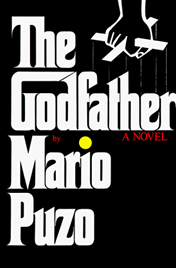
The Godfather is a crime novel by American author Mario Puzo. Originally published in 1969 by G. P. Putnam's Sons, the novel details the story of a fictional Mafia family in New York City, headed by Vito Corleone, the Godfather. The novel covers the years 1945 to 1955 and includes the back story of Vito Corleone from early childhood to adulthood.

Michael Corleone is a fictional character and the protagonist of Mario Puzo's 1969 novel The Godfather. In the three Godfather films, directed by Francis Ford Coppola, Michael was portrayed by Al Pacino, for which he was twice-nominated for Academy Awards. Michael is the youngest son of Vito Corleone, a Sicilian immigrant who builds a Mafia empire. Upon his father's death, Michael succeeds him as the don of the Corleone crime family.

Vito Corleone is a fictional character in Mario Puzo's 1969 novel The Godfather and in the first two of Francis Ford Coppola's film trilogy. Vito is originally portrayed by Marlon Brando in the 1972 film The Godfather, and later by Oreste Baldini as a boy and by Robert De Niro as a young man in The Godfather Part II (1974). He is an orphaned Sicilian immigrant who builds a Mafia empire.

Frederico "Fredo" Corleone is a fictional character in Mario Puzo's 1969 novel The Godfather. Fredo is portrayed by American actor John Cazale in the Francis Ford Coppola 1972 film adaptation and in the 1974 sequel, The Godfather Part II.

Santino "Sonny" Corleone is a fictional character in Mario Puzo's 1969 novel The Godfather and its 1972 film adaptation.

Vincent SantinoCorleone is a fictional character in the 1990 feature film The Godfather Part III. He is portrayed by Andy García, who was nominated for an Academy Award for his performance.
The Corleone family are fictional characters in both the novels and the films created by Mario Puzo, first appearing in his 1969 novel, The Godfather. They are an organized crime family originating from the Sicilian town of Corleone, and based in New York City.

Thomas Hagen is a fictional character in Mario Puzo's 1969 novel The Godfather and Francis Ford Coppola's films The Godfather (1972) and The Godfather Part II (1974). He is portrayed by Robert Duvall in the films. He also appears in the Mark Winegardner sequel novels The Godfather Returns and The Godfather's Revenge, as well as Ed Falco's novel The Family Corleone. Duvall was nominated for an Academy Award for Best Supporting Actor and a BAFTA for his performance in the first film.

The Godfather is a 2006 open world action-adventure video game developed by EA Redwood Shores and published by Electronic Arts. It was originally released in March 2006 for Microsoft Windows, PlayStation 2, and Xbox. It was later released for the PlayStation Portable, Xbox 360, Wii, and PlayStation 3.
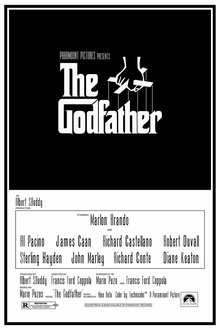
The Godfather is a 1972 American epic crime film directed by Francis Ford Coppola, who co-wrote the screenplay with Mario Puzo, based on Puzo's best-selling 1969 novel of the same title. The film stars Marlon Brando, Al Pacino, James Caan, Richard Castellano, Robert Duvall, Sterling Hayden, John Marley, Richard Conte and Diane Keaton. It is the first installment in The Godfather trilogy, chronicling the Corleone family under patriarch Vito Corleone (Brando) from 1945 to 1955. It focuses on the transformation of his youngest son, Michael Corleone (Pacino), from reluctant family outsider to ruthless mafia boss.

Peter Clemenza is a fictional character who first appeared in Mario Puzo's 1969 novel The Godfather. He is played by Academy Award-nominee Richard Castellano in Francis Ford Coppola's 1972 film adaptation of the novel, and by Bruno Kirby in The Godfather Part II (1974).
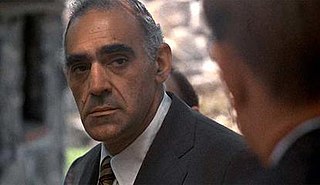
Salvatore "Sal" Tessio is a fictional character in Mario Puzo's 1969 novel The Godfather, as well as two of the films based on it: The Godfather (1972) and The Godfather Part II (1974). His given name was created for the films; in the novel he is referred to only as "Tessio". In the film The Godfather, Tessio was portrayed by Abe Vigoda. In The Godfather Part II, John Aprea portrayed the younger Tessio, while Vigoda reprised the role in a flashback, set in late 1941, at the end of the film.

Albert "Al" Neri is a fictional character appearing in Mario Puzo's 1969 novel The Godfather and Francis Ford Coppola's trilogy of films based on it. In all three motion pictures, he is portrayed by actor Richard Bright. He functions as Michael Corleone's personal enforcer, bodyguard and assassin.

Emilio "The Wolf" Barzini is a fictional character and the main antagonist in Mario Puzo's 1969 novel The Godfather and in its 1972 film adaptation, in which he is portrayed by Richard Conte. The Barzini crime family was inspired by the Genovese crime family.
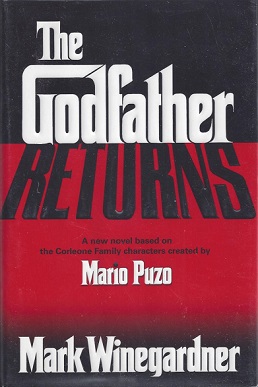
The Godfather Returns is a novel written by author Mark Winegardner, published in 2004. It is the sequel to Mario Puzo's 1969 novel The Godfather and The Sicilian (1984). The publisher, Random House, selected Winegardner to write a sequel after Puzo's death. As the original novel covered the years 1945 to 1955, and included significant backstory on Don Vito Corleone's life, Returns covers the years 1955 to 1962, and includes significant backstory on Michael Corleone's life prior to the first novel. It is the third book in The Godfather series of novels.

The Godfather's Revenge, a 2006 novel written by author Mark Winegardner, is the sequel to his 2004 novel The Godfather Returns. It is the fourth book in The Godfather novel series and is chronologically set last.

Don Fanucci is a fictional character appearing in Mario Puzo's 1969 novel The Godfather and the 1974 film The Godfather Part II, a sequel to the 1972 film version of Puzo's novel. Fanucci is portrayed by Gastone Moschin and is based on the personality of Ignazio Lupo, a real-life Black Hand figure.

The Family Corleone is a 2012 novel by Ed Falco, based on an unproduced screenplay by Mario Puzo, who died in 1999. It is the prequel to Puzo's The Godfather. It was published by Grand Central Publishing and released May 8, 2012. It is the fifth and final book published in The Godfather novel series but, being a prequel, it is chronologically set first.
The Godfather book series is a series of crime novels about Italian-American Mafia families, most notably the fictional Corleone family, led by Don Vito Corleone and later his son Michael Corleone. The first novel, The Godfather, written by Mario Puzo, was released in 1969. It was adapted into a series of three feature films, which became one of the most acclaimed franchises in film history.
